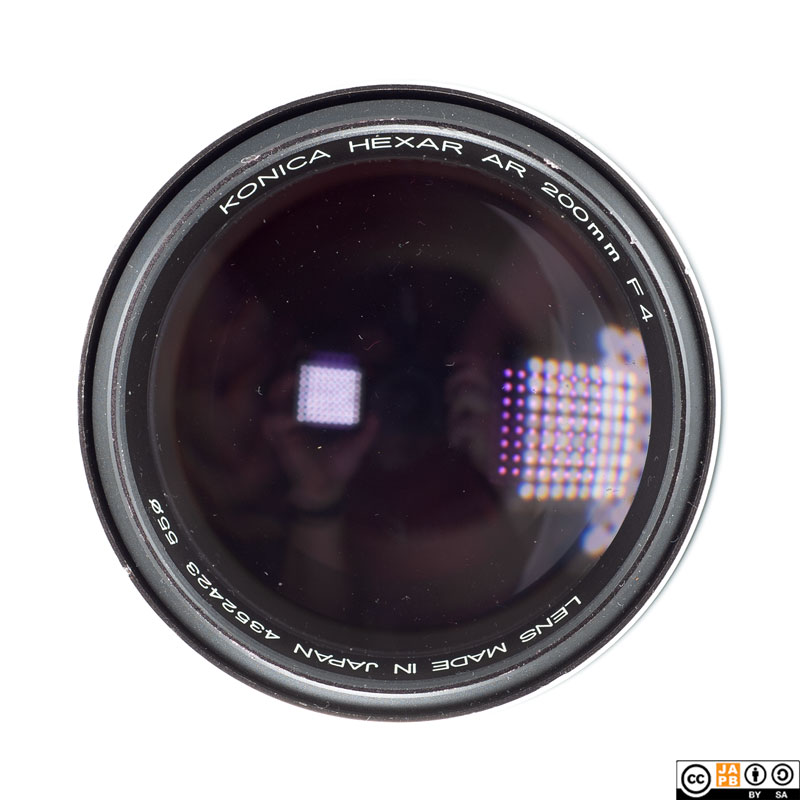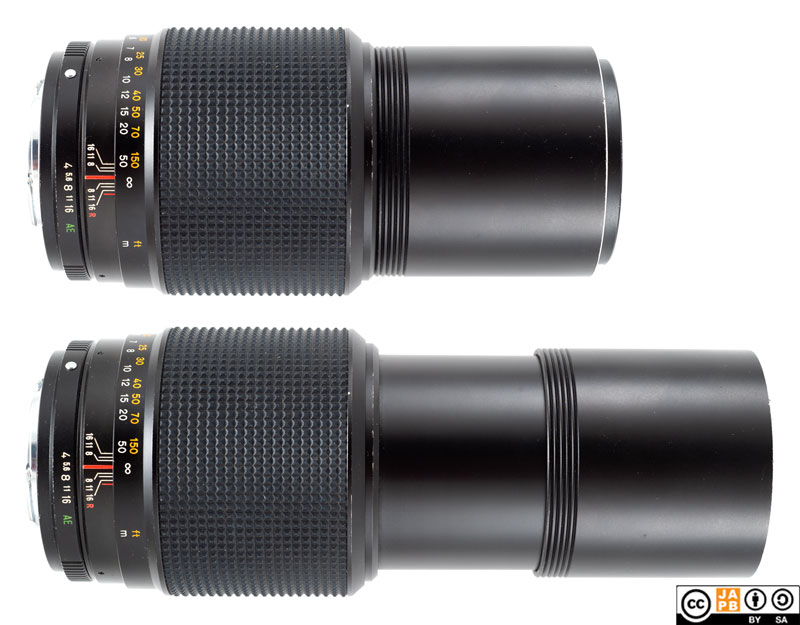Pekka Buttler, 03/2024

Specifications
The table below summarizes the lens’ key specifications (measurements based on pictured, last version of the lens):
| Brand: | Konica | Lens name | HEXAR AR 200mm F4 |
| Focal length(s)1 | 200 mm | Angle-of-view 2 | 12° |
| Maximum Aperture | f/4 | In Production | 1975–1978 |
| Lens mount | Konica AR | Subfamily (if applicable) | –– |
| Length 3 | 152,7 mm | Diameter 4 | 74,5 mm |
| Filter ring diameter | 55 mm | Weight | 803 grams |
| Lens element count | 4 | Lens group count | 4 |
| Aperture blades (S/R/C) 5 | 6 S | Focus throw | 200 ° |
| Minimum focusing distance | 2,5 m | Maximum magnification | 1:10,4 |
| Has manual aperture ring | YES | Has Manual focus ring | YES |
| Aperture mechanism type | Automatic | Aperture click stops 6 | 4-5.6-8-11-16 |

Further notes:
• In 1975 Konica introduced a lineup of three lenses under the name ‘Hexar’ next to the established and respected line of ‘Hexanon’ lenses. These three were a Hexar 28 mm f/3.5 [data sheet] a Hexar 135 mm f/3.5 and a Hexar 200 mm f/4 lens (this lens). The Hexar lenses were from the onset intended for the budget-first consumer. Typically Hexar lenses differed from contemporary Hexanons by a combination of a) simpler optical designs; b) less compact constructions; c) smaller max apertures (in the case of the 135 and 200 mm Hexars); d) lower quality packaging.
• While the Hexar lenses sold relatively well, they were promptly discontinued in 1978 in favour of a new lineup of budget-friendly Hexanon lenses. Both the Hexanon 200 mm f/3.5 [data sheet] and 200 mm f/4 Hexar were replaced by a 200 mm f/4 Hexanon [data sheet]
• While the Hexar lenses look like Konica lenses, established consensus is that Konica outsourced the design and manufacture of the Hexars to Tamron.
• The most striking characteristic of the 200 mm Hexar is that it’s a big lens. At a diameter of almost 75 mm its focus ring looks bulky, and at ≈800 grams it is a heavy lens for these specifications.
• The 200 mm Konica Hexar uses a built-in, extendable hood. For once the extension of that hood is long enough to be effective against more than oblique rays.

Bottom: Konica Hexar AR 200 mm f/4 lens with hood extended.
Versions
Only one version of the Konica Hexar AR 200 mm f/4 was ever made.
History of Konica AR lenses
Konica is one of those names that will not ring any bells to those who’ve only recently started photographing, but for many years Konica was one of the ‘Great Japanese camera companies’.
After a short-lived and only moderately successful line of SLR cameras known as the Konica F-line (1960-1965), Konica hit pay dirt with the introduction of the Konica Auto-Reflex in 1965 and its new, Konica AR mount. The Auto-Reflex was at the time the first affordable system camera with integrated auto-exposure (albeit the exposure metering was not yet TTL). The Auto-Reflex was followed by a two lines of successful cameras – the more ambitious Autoreflex T-line and the more pedestrian Autoreflex A-line – before Konica (along with the rest of Japanese camera companies) stepped up the automation of their SLR cameras with the 1-series (FS-1, FC-1, FP-1, and FT-1).
But while Konica had often been at the forefront of automation (first shutter priority auto-exposure system, first SLR with integrated winder), Konica’s star had been waning, and Konica decided to not compete against the likes of Minolta, Nikon, Canon, and Pentax in autofocus technology. Instead Konica withdrew from SLR and SLR lens manufacture and focused on compacts and other optoelectronics. Two decades later Konica merged with Minolta to form KonicaMinolta, which subsequently sold its camera business to Sony. So, after a fashion, the DNA of Konica’s camera business lives on in Sony’s camera division.
Relevantly, the Konica AR mount had a relatively good and long (1965–1987) run, and stayed remarkably unchanged throughout. Hence, while Konica changed the design of their AR lenses during those years – moving towards lighter constructions, rubber focus rings, and a more modern look (for more detail, look here) – all AR lenses are physically entirely compatible with all AR-mount bodies.´
Adapting
n.B! The following applies to all Konica AR mount lenses.
This lens cannot be used natively on any current SLR or dSLRs. To use it in its native environment, you will need a Konica AR-mount film body.
Thanks to being a fully manual lens (manual aperture, manual focus), the lens can be adapted to all mirrorless cameras using a suitable adapter. Moreover, Konica AR lenses are so uncomplicated that a simple ‘dumb adapter’ will do the job perfectly. However, due to Konica AR lenses not being among the most numerously manufactured, special adapters (helicoid adapters, tilt/shift adapters) are not easy to come by and speed boosters are currently unavailable.
Using Konica AR lenses on dSLRs is possible, but difficult. Due to the exceptionally short flange focal distance of the Konica AR mount (at 40,5 mm, a lot shorter than that of any full-frame dSLR mount), any adapter will necessitate some optics to achieve anything near infinity focus.
Footnotes
- Focal length is (unless stated otherwise) given in absolute terms, and not in Full-frame equivalent. For an understanding of whether the lens is wide/tele, see ‘Angle-of-view’. ↩︎
- Picture angle is given in degrees (based on manufacturers’ specs) and concerns the diagonal picture angle. Rule of thumb:
> 90 ° ==> Ultra-wide-angle
70–90 ° ==> Wide-angle
50–70 ° ==> Moderate wide-angle
40–50 ° ==> ‘Standard’ or ‘normal’ lens
20–40 ° ==> Short tele lens
10-20 ° ==> Tele lens
5-10 ° ==> Long tele lens
< 5 ° ==> Ultra-tele lens ↩︎ - Length is given from the mount flange to the front of lens at infinity. ↩︎
- Diameter excludes protrusions such as rabbit ears or stop-down levers. ↩︎
- S=straight; R=rounded; C=(almost)circular at all apertures. ↩︎
- Numbers equal aperture values on aperture ring; • intermediate click; – no intermediate click. ↩︎